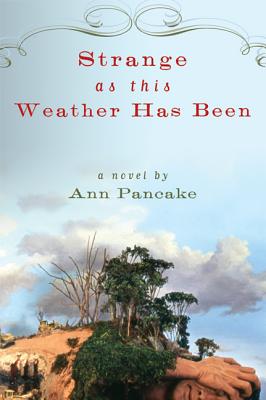Ann Pancake’s powerful novel STRANGE AS THIS WEATHER HAS BEEN does what a truly great book does best: it reveals our humanity in the midst of beauty and grief and heartbreak and joy, while simultaneously opening our eyes to something we all need to see—in this case, environmental disaster—without ever sacrificing character or story.
Set in a West Virginia town in the midst of a coal boom, the novel introduces a family plagued by poverty and by the effects of the mountaintop removal mining that is destroying the land around them.
While the novel is told through the eyes of several characters living amid the ruinous effects of coal mining, this story belongs mostly to Lace and her teenage daughter, Bant, born when Lace herself was a teenager. In these pages we see the daily struggles of those who live amid mountain-removal mining: the constant fear of “black floods” (rivers of coal sludge that come from pools of toxic waste) weighed against a desperate need for work; the memories of what once was versus the wasteland that now exists. Lace and Bant are deeply connected to the land and feel these effects more strongly than most, in their very bones.
Pancake, who is from West Virginia, writes with a stunning authenticity, drawing from conversations and interviews with people who have lived through mountaintop removal mining, and she’s dedicated this book to them. “Nowhere have I seen courage and integrity like theirs,” she writes, and this spirit is reflected in each of her characters.
Place is also a major character in this novel; the richness of detail and the characters’ history with the land reveal why it’s so hard for them to leave, even when the jobs begin to disappear and threats loom everywhere, from within the coal miners’ lungs to the flooding of toxic black water.
At one point, the family does leave West Virginia, temporarily, when Lace’s husband, Jimmy Make, gets a job in Raleigh, North Carolina. Despite the necessity of the move, Lace misses home “so bad I’d feel land in my throat.” Yet once back home, tensions escalate both within the region as more blasting continues and within the family as Lace becomes involved with anti-mining activists and Jimmy Make resists.
When Bant, who takes after her mother in passion and intensity, sees the mountain in whose shadow she’d grown up destroyed, it affects her deeply: “What I saw punched my chest. Knocked me back on my heels. At first I saw it only as shades of dead and gray, but I pushed my eyes harder, I let come in the hurt, and then it focused into a cratered-out plain.”
STRANGE AS THIS WEATHER HAS BEEN succeeds not only as the unforgettable story of a family, a region, a culture—the novel indirectly asks readers to think about where their power comes from, and what the costs of coal truly are. Pancake’s novel masterfully raises our awareness about mountaintop removal mining and the lives affected by it. As Lace says in the novel: “Stay in their way—that’s the only language they can hear. We are from here, it says. This is our place, it says. Listen here, it says. We exist.”





